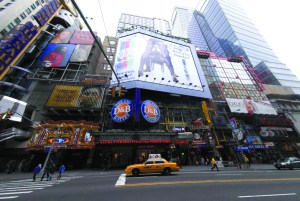 When a city’s momentum is relentlessly upward, it’s the things at the margins—outcasts and dormant mythologies, secrets and barely conscious desires—that get pushed below ground. Hubert’s Museum was one of those things, a continuous theater of the grotesque and the uncanny stirring beneath 42nd Street. When it shut its doors at 234 West 42nd Street in 1965, it was the last of the midtown dime museums, a tawdry anachronism caught between the roulette spins of Times Square.
When a city’s momentum is relentlessly upward, it’s the things at the margins—outcasts and dormant mythologies, secrets and barely conscious desires—that get pushed below ground. Hubert’s Museum was one of those things, a continuous theater of the grotesque and the uncanny stirring beneath 42nd Street. When it shut its doors at 234 West 42nd Street in 1965, it was the last of the midtown dime museums, a tawdry anachronism caught between the roulette spins of Times Square.
You paid your dime in a cramped little booth (toward the end, it cost a whole 40 cents), then descended into a den of mirrors, elongating and distorting, your flesh doing contortionist tricks. You went down “like Orpheus or Alice or Virgil,” wrote Diane Arbus. Submerged, you found yourself suddenly too big, then too small, “all around you like flowers a thousand souvenirs of human aberrations, as if the world had quite literally stashed away down there everything it didn’t need.”
The show-continuous, as you were reminded at every opportunity-ran every half-hour, its glassy-eyed curiosities materializing onstage one by one: Albert-Alberta, the half-man, half-woman; a kid called the Human Canary; Congo the Jungle Creep (from Haiti, in fact); the World’s Tallest Cowboy; the Backwards Man. For five minutes each, they sent back aloof stares, answered questions or disregarded them. At the end, the fez-wearing maestro ushered the crowd into the next room (for an extra coin or two), where the real circus happened: Professor Heckler’s world-famous flea troupe.
The flea circus was founded in 1923 by William Heckler, author of likely the defining treatise on the art of flea training, Pulicology. The troupe generally numbered around 16 (six principals, 10 understudies), and each miniscule performer, according to the professor, had its own distinct personality. (Heckler’s favorite was an Irish flea called Paddy.) They juggled, raced chariots and played a xylophone fashioned out of fingernail shavings. In the final and most anticipated act, the professor’s “stars” staged a ballroom dance adorned in tiny gowns and tuxedos. In Heckler’s obituary, it was recalled that he “always fed his pets himself.”
HUBERT’S ARRIVED ON 42nd Street on the heels of Prohibition, which was morphing Times Square from the gilded playground of Manhattan high society to a speakeasy pleasure house of the working class.
Murray’s Roman Gardens opened in 1908, the most famous of the gout-inducing “lobster palaces” that sprang up from 42nd Street tenements. Presaging the resplendent camp of the theme restaurant, and the modern casino’s tacky splendor, Murray’s Romanesque décor was a nod to gluttonous sensuality. Architect Henry Erkins installed a rotating dance floor in the middle of the Pompeian-themed dining room, its faux sky bejeweled with electric stars and equipped with moving clouds. Not to be outdone, the other floors included a full-size Cleopatra’s barge, nude nymphs, suspended mirrors, a Peking-themed “Dragon Room” and a 30-foot marble fountain designed by high-society starchitect Stanford White. According to a restaurant advertisement, “24 luxuriously furnished and richly appointed bachelor apartments” were handily kept on the premises.
“Dry agents” raided Murray’s several times before it finally surrendered to the 18th Amendment in 1923. Hubert’s freaks and fleas appropriated the building’s six stories of rococo detail, though they, too, were displaced a decade later, relegated underground as midtown marginalia succumbed to mainstream tastes. Sideshows gave way to movie theaters and arcades, 42nd Street already on its way toward today’s midway of mass marketing. The palatial movie theaters would become grindhouses and triple-X video emporiums and finally brand-name retail flagships, in all their engorged, boxy sheen. The arcades and pinball machines would mutate into peepshows and massage parlors, then eventually revert back to arcades, Nintendo and Viacom the newly instated impresarios.
In the 1970s, Hubert’s basement became Peepland, which, somewhat like its predecessor, trafficked in transgressive spectacle and bodily deviancies. Peepland’s headliners, however, drew more from nuns and eels than fleas in miniature ball gowns. In his Tales of Times Square, Josh Alan Friedman called it a “Disneyland in hell.” Meanwhile, the floors above Peepland housed the notorious male brothel the Barracks, where the remaining statues of Murray’s fleshly Roman revival provided the running commentary to history’s cyclical ironies.


